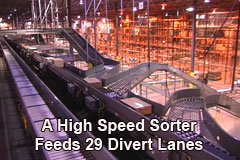|
Sortation System
The WMS logically pre-built the pallets based on carton cube, and the conveyor control system sent the cartons to the proper divert lane according to this pallet distribution. Two of the diverts were devoted to small parcel shipments and went straight into dropped parcel trailers, but most were used for LTL and some truckload pallet building. In some cases, especially for the company’s own outlet stores, the WMS allocated full pallets and directed them straight to staging lanes.
Cartons that required customer-specific price ticketing flagged by the WMS and sorted to a special area near the divert lanes, ticketed, then placed back onto the sorter for the final divert.
 The system employed “wave overlap,” a fairly common practice today, but still rare in 1998. There were a given number of pallet building locations at the end of each divert. As pallets were “closed,” and the position freed up, cartons for the next wave would start being diverted to that lane, even if the other pallets being worked on were still for the previous wave. The system employed “wave overlap,” a fairly common practice today, but still rare in 1998. There were a given number of pallet building locations at the end of each divert. As pallets were “closed,” and the position freed up, cartons for the next wave would start being diverted to that lane, even if the other pallets being worked on were still for the previous wave.
This approach, which required some modifications to the WMS and conveyor control system, significantly reduced the down time experienced in most sortation systems at that time due to the requirement to completely clear a wave off the sorter before releasing cartons from the next wave.
System Improvement over 10 Years
Baker said that it took them 2 to 3 seasons to learn how to use the system to its full potential. At that point, they began to make subtle operational changes to enhance system performance and to accommodate new products and customer order profiles. In addition, totes Isotoner has made various upgrades to the system based on advances in equipment design, controls and software technology, including upgrading the WMS and the Forte conveyor control system.For example, the original design spread the highest moving SKUs, such as a basic black umbrella, over several split case picking locations, because of concern that in peak season there would be too much congestion at those locations.
Experience proved that congestion was not a major issue, so a change was made to slot even high volume SKUs in a single location, in some cases, using many lanes of the carton flow rack. In parallel, the rack labeling in split case was changed to an innovative color scheme that lets pickers know about how many lanes there are for that location (one to a dozen or more).
In the split case area, completed cartons were originally “closed” in the split case zone by pickers. Baker said that this sometimes led to confusion as to which carton content’s label was the right one for each carton (multiple labels could have printed out for different closed cartons) and disrupted the picking flow. So, completed cartons are now sent via the sorter to the ticketing area for closure (dunnage, sealing, labeling).
(Distribution and Materials Handling Article - Continued Below)
|